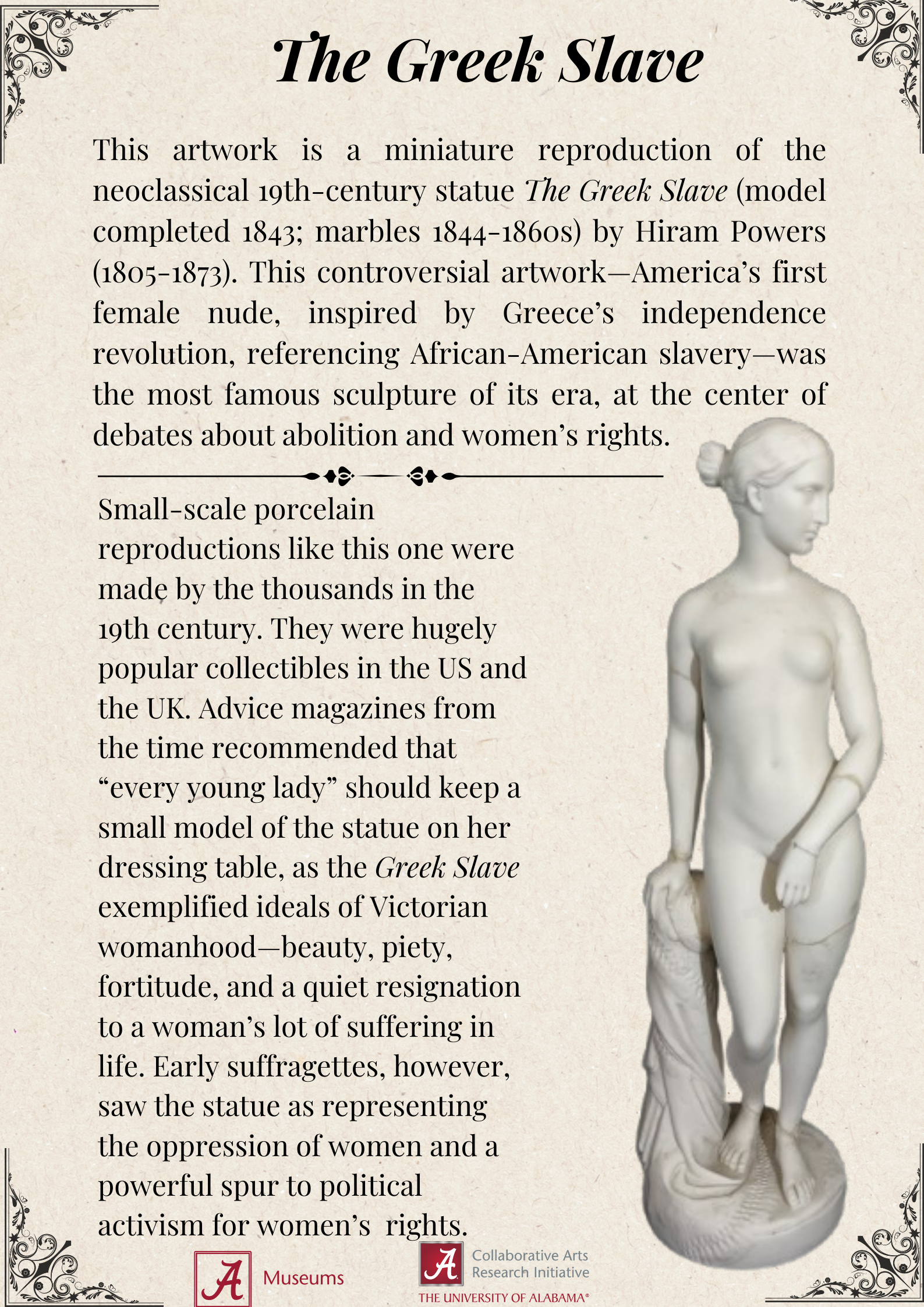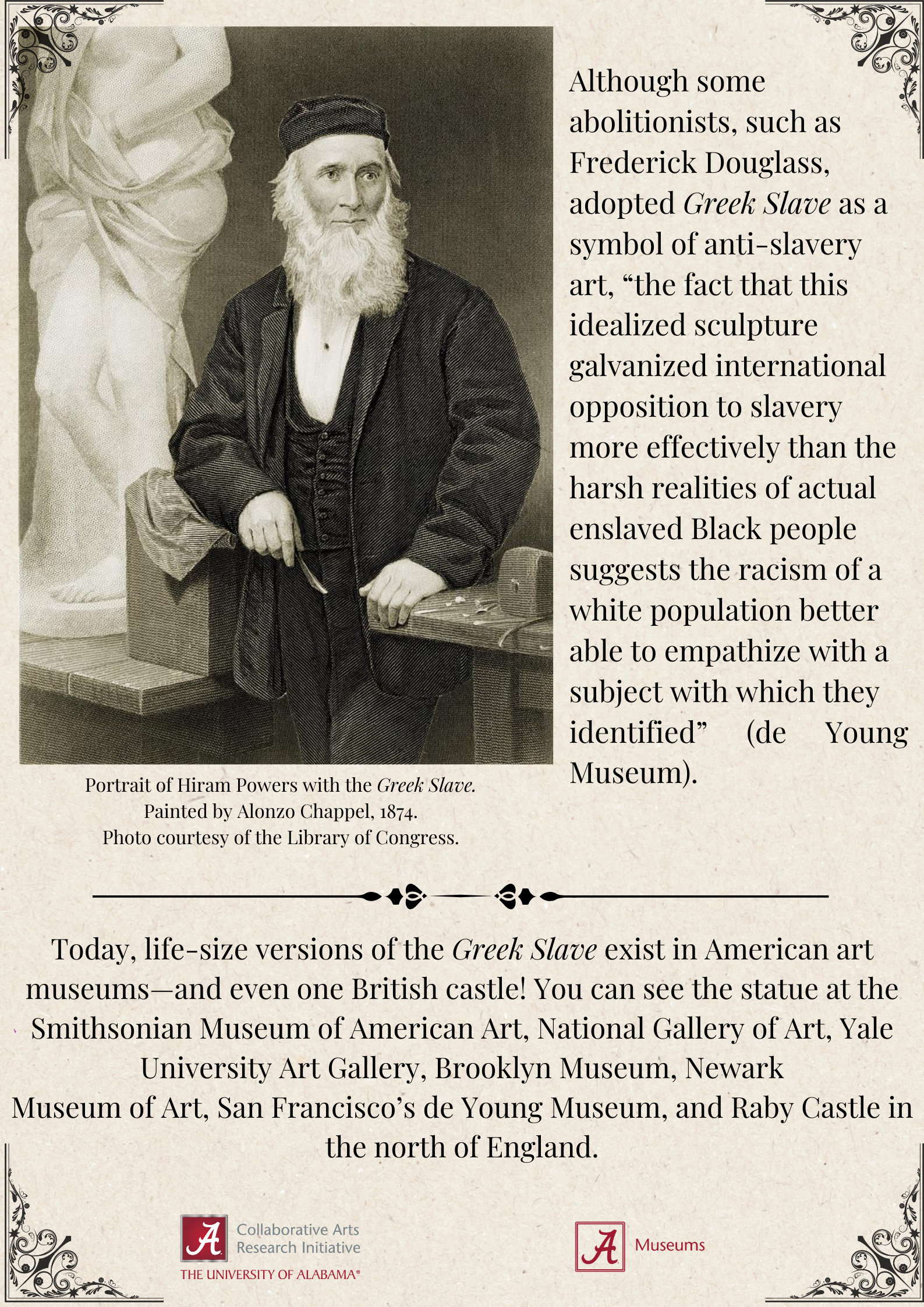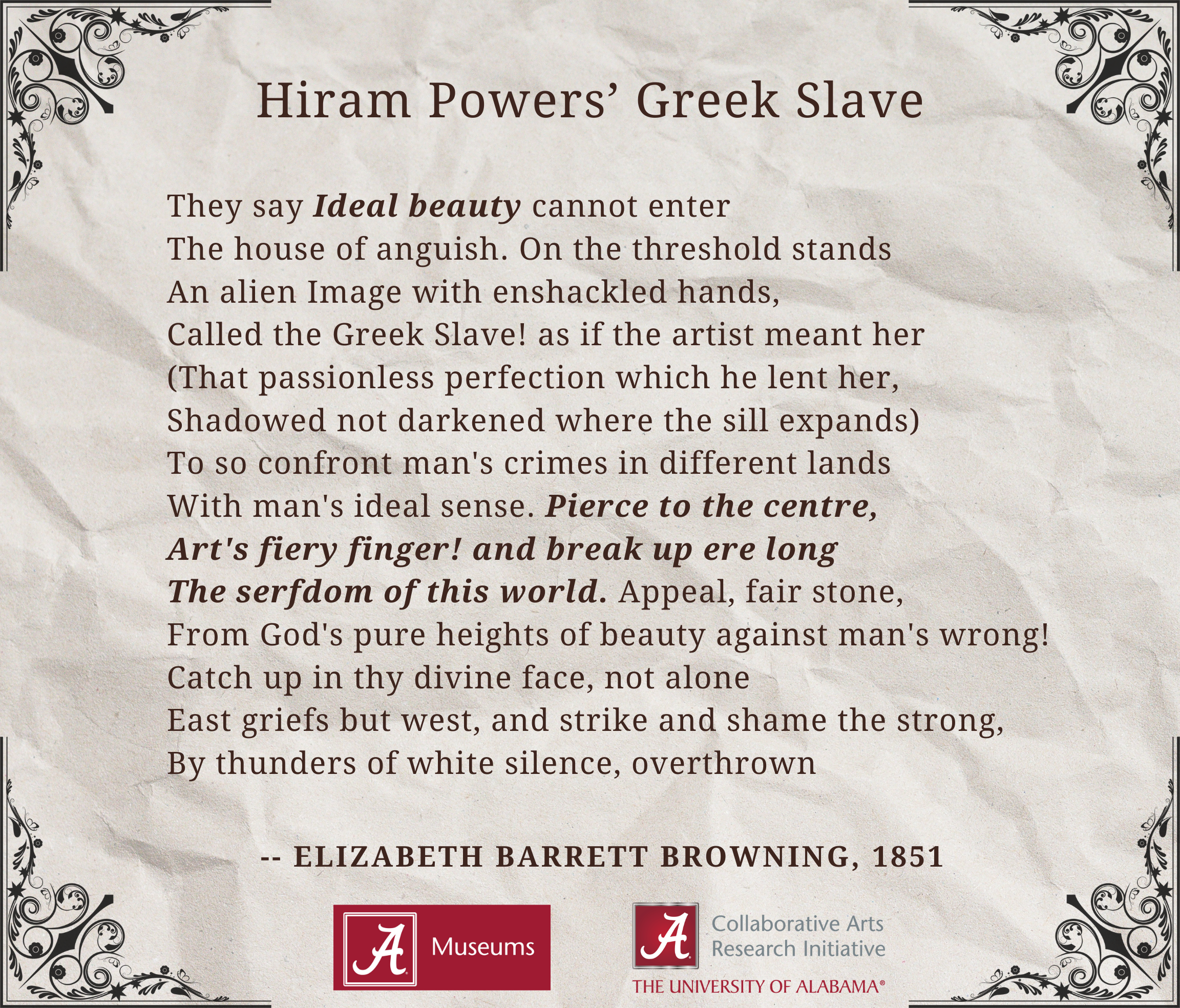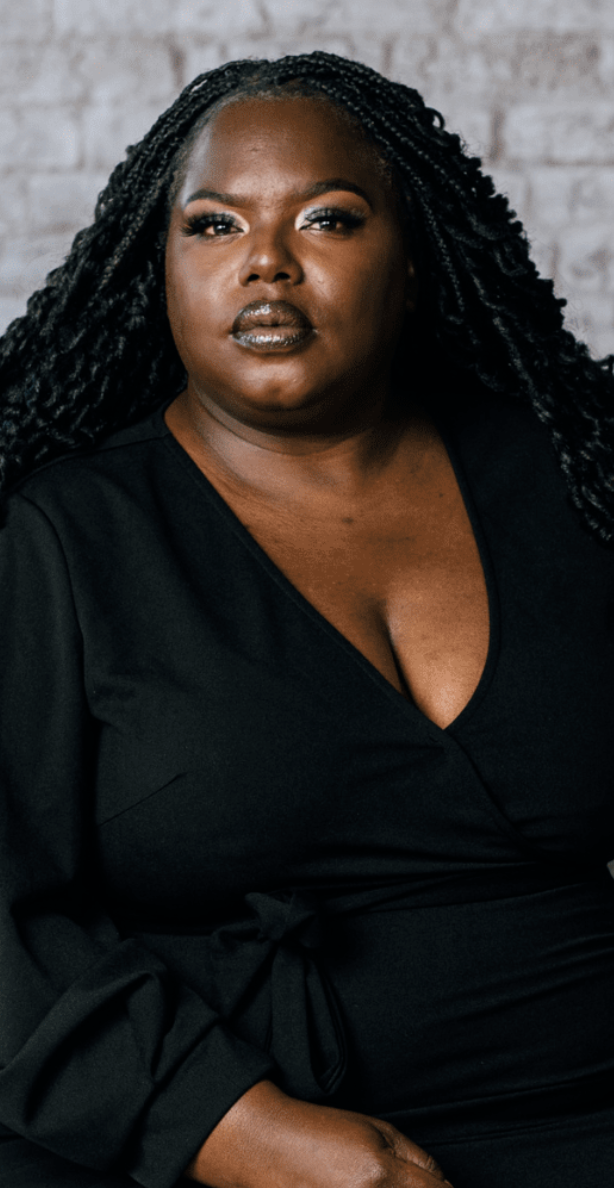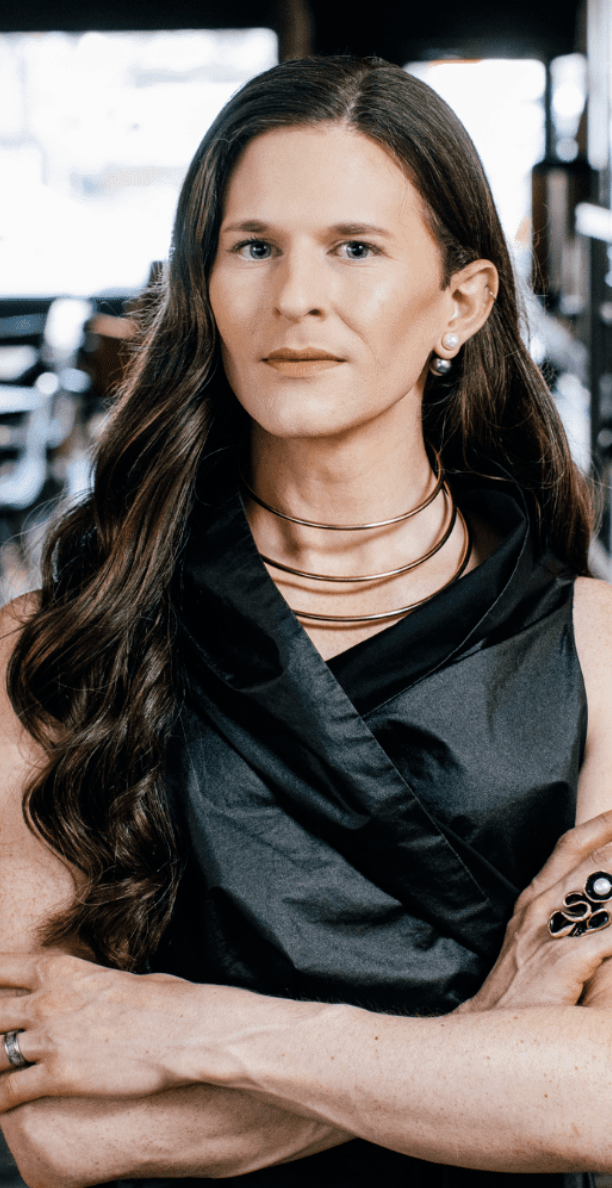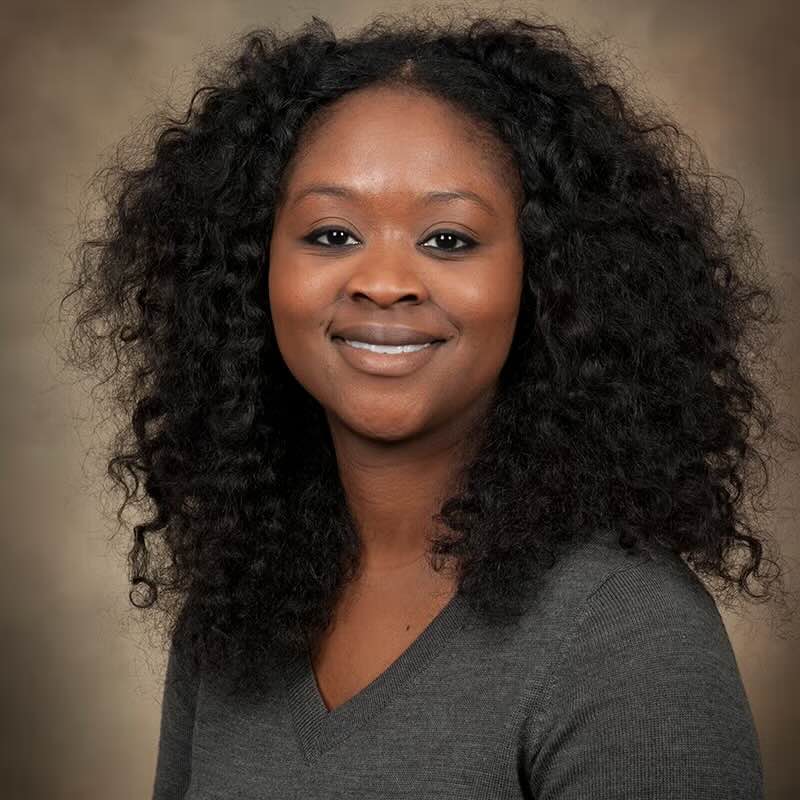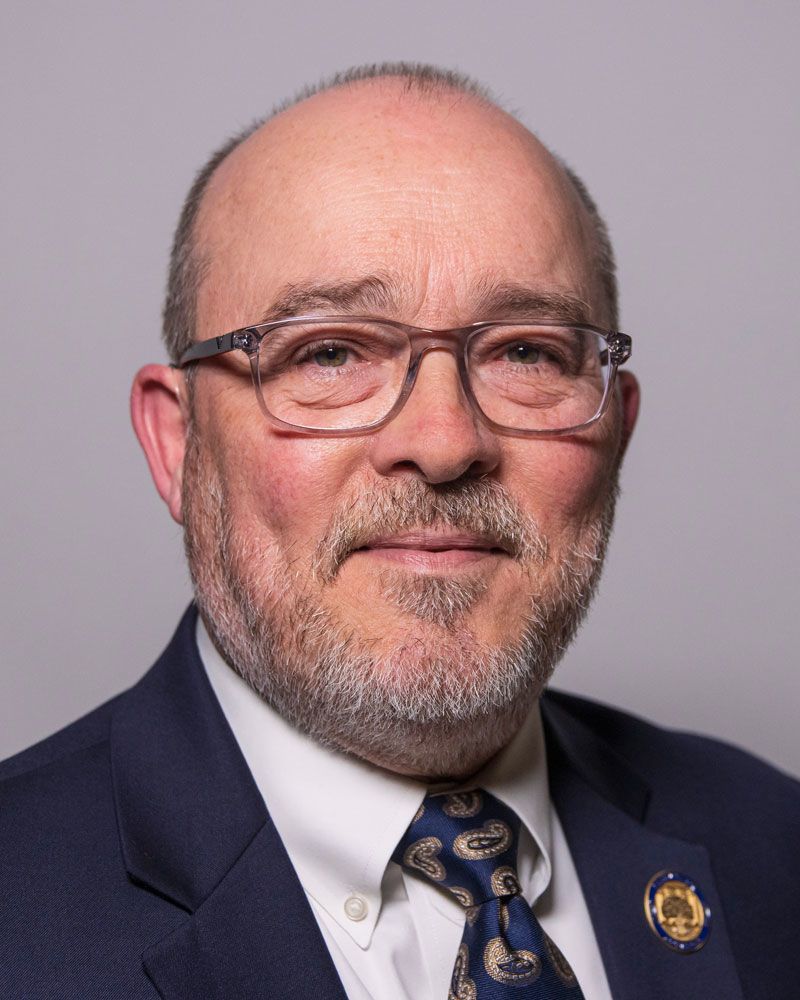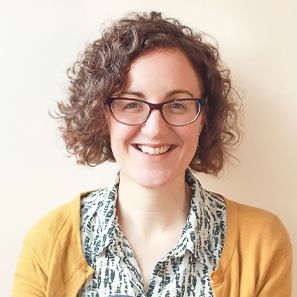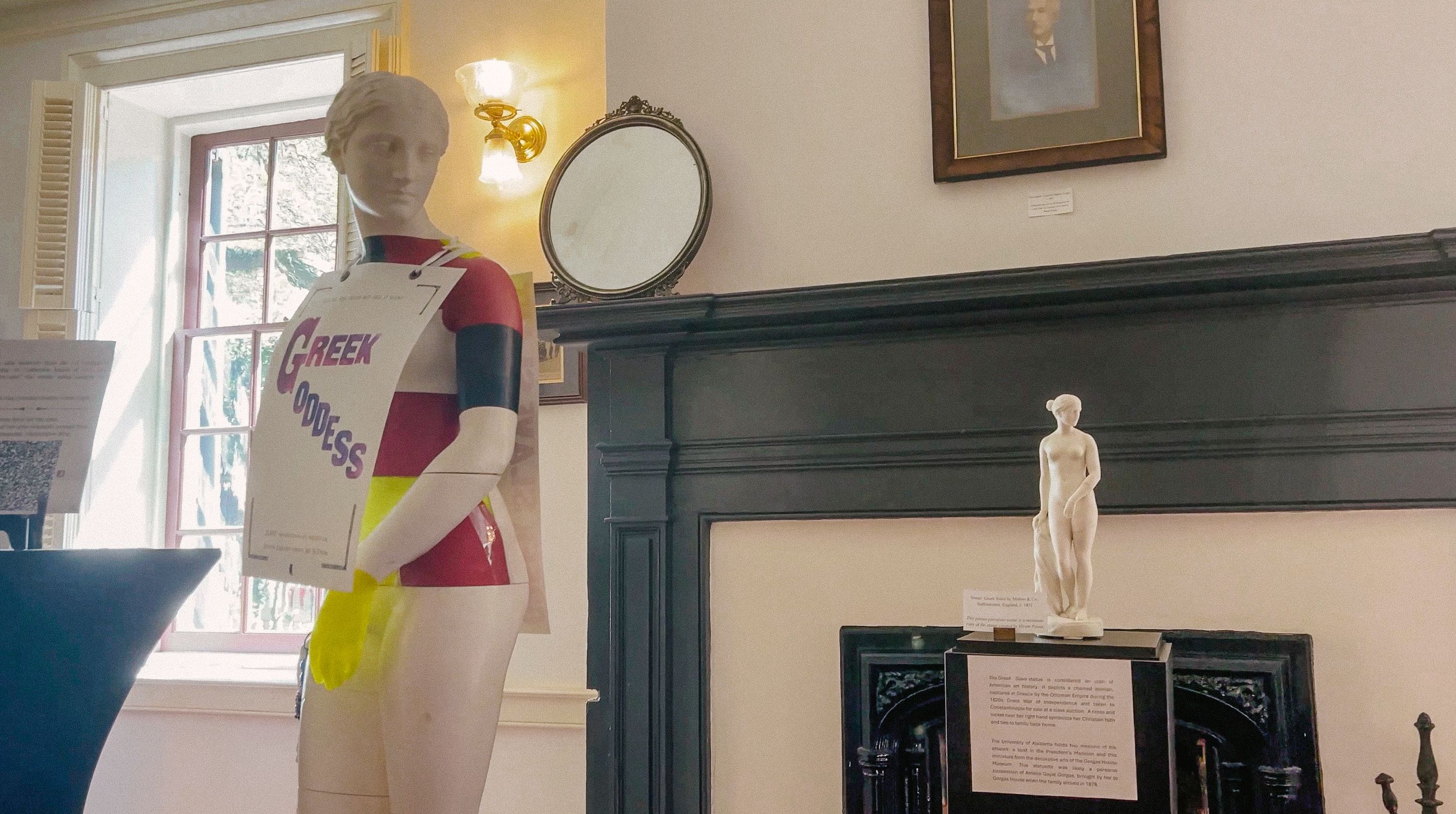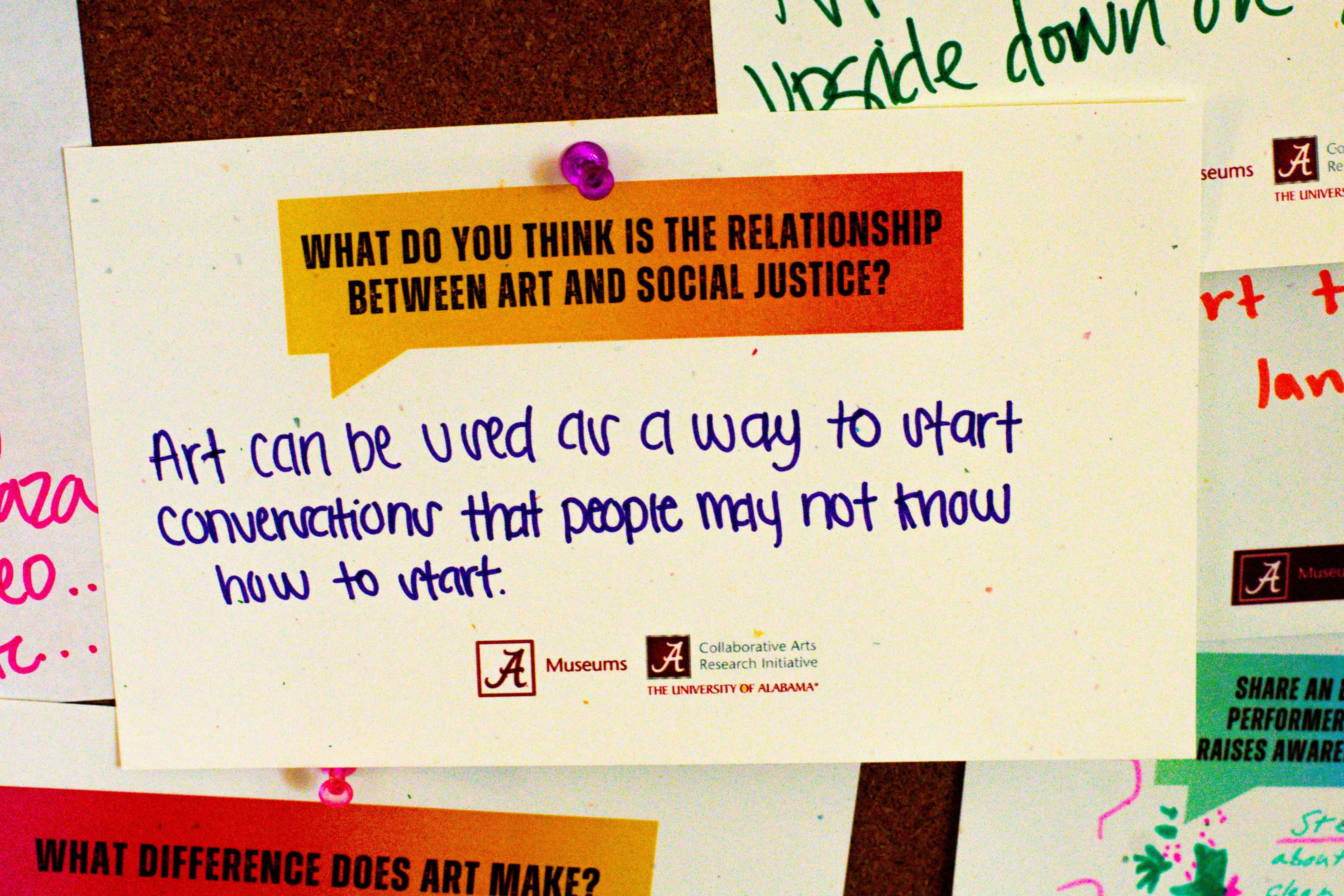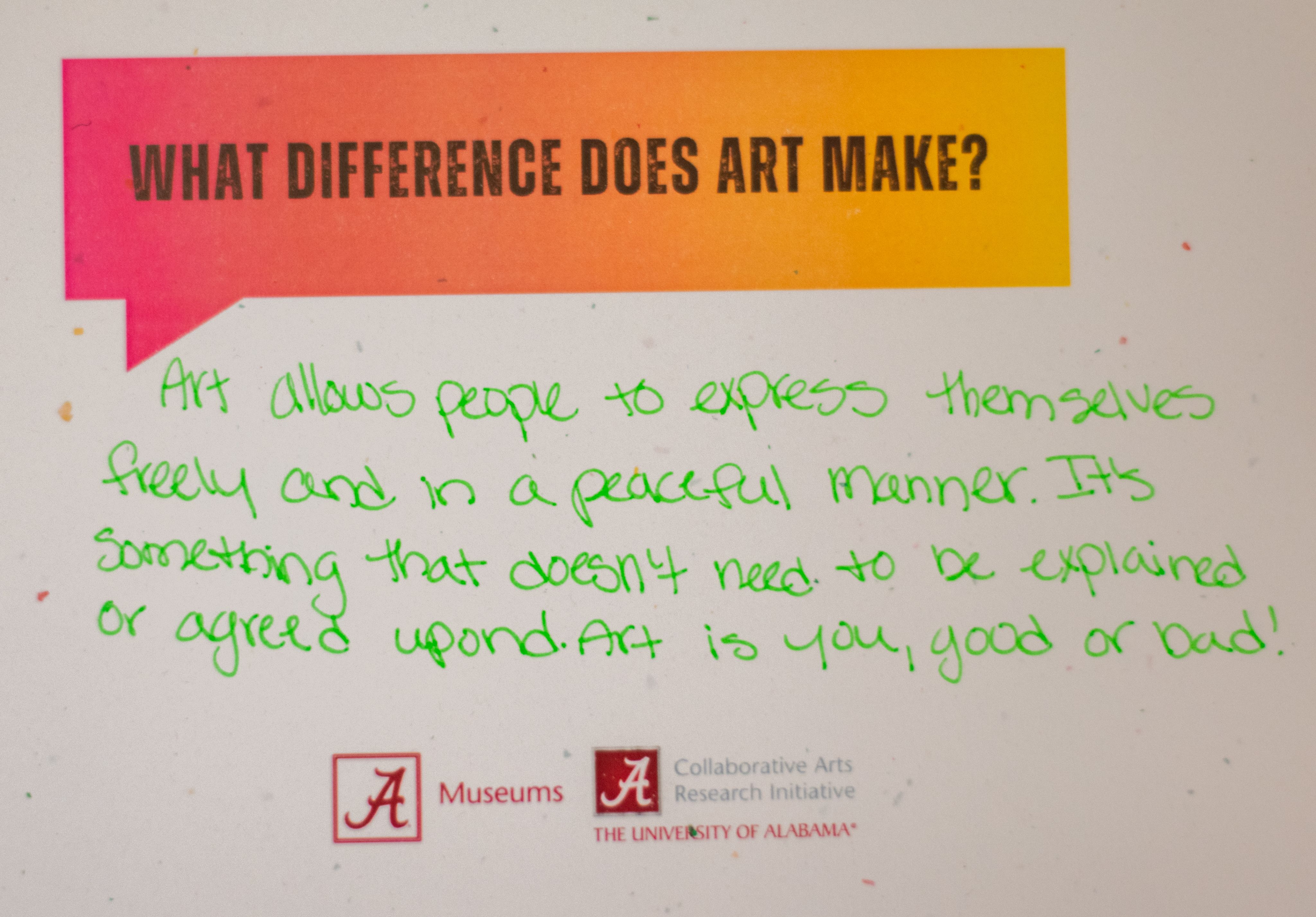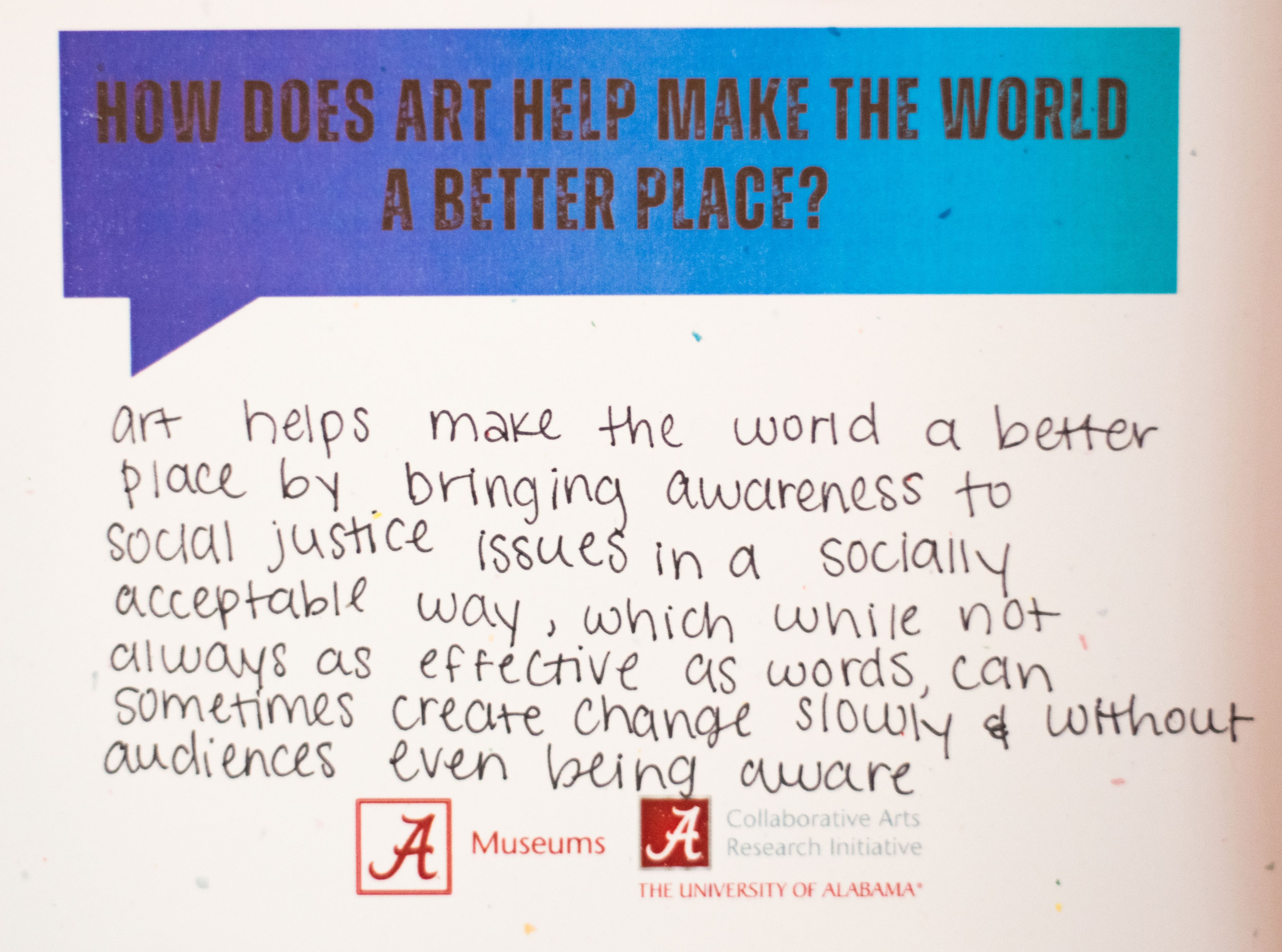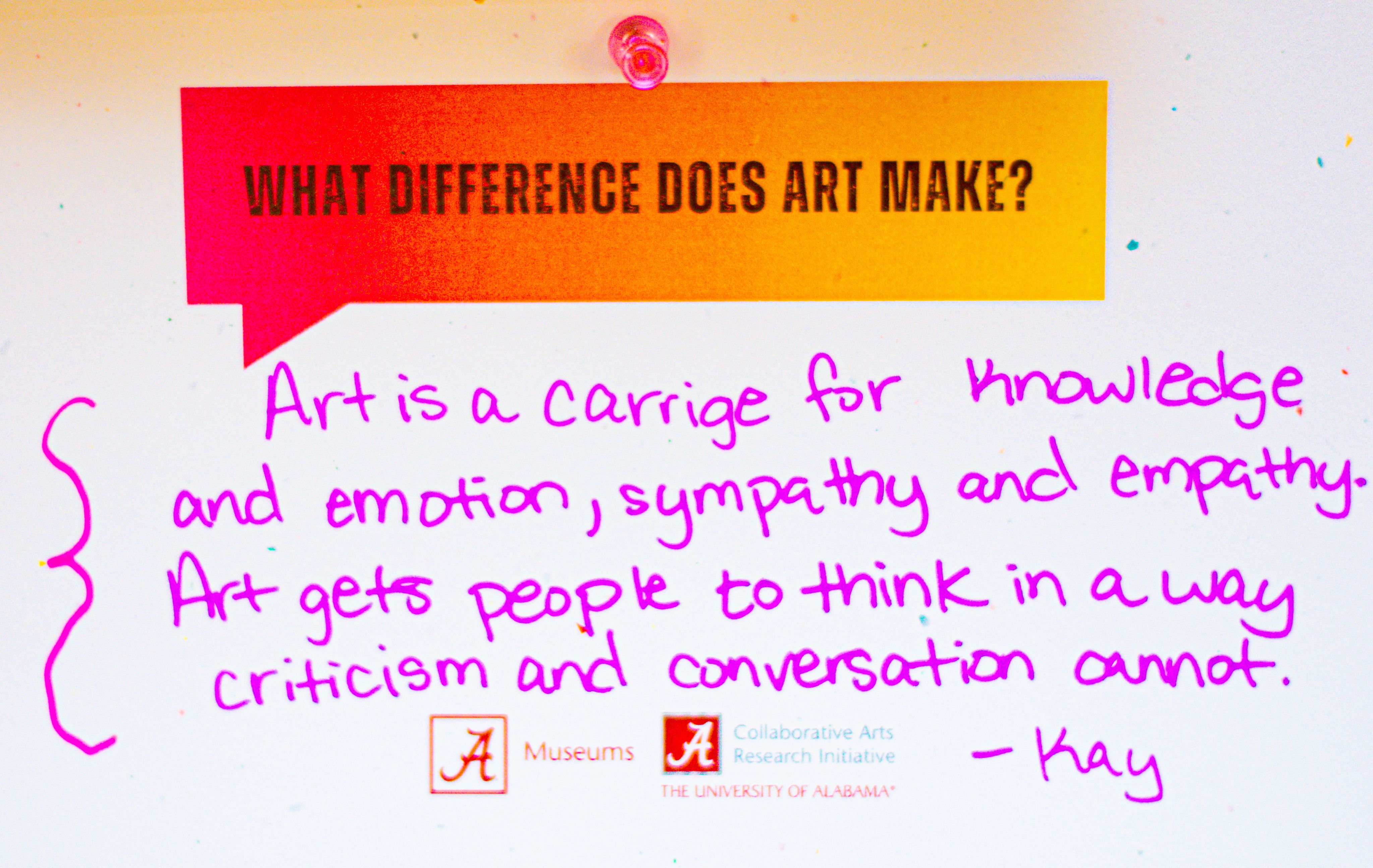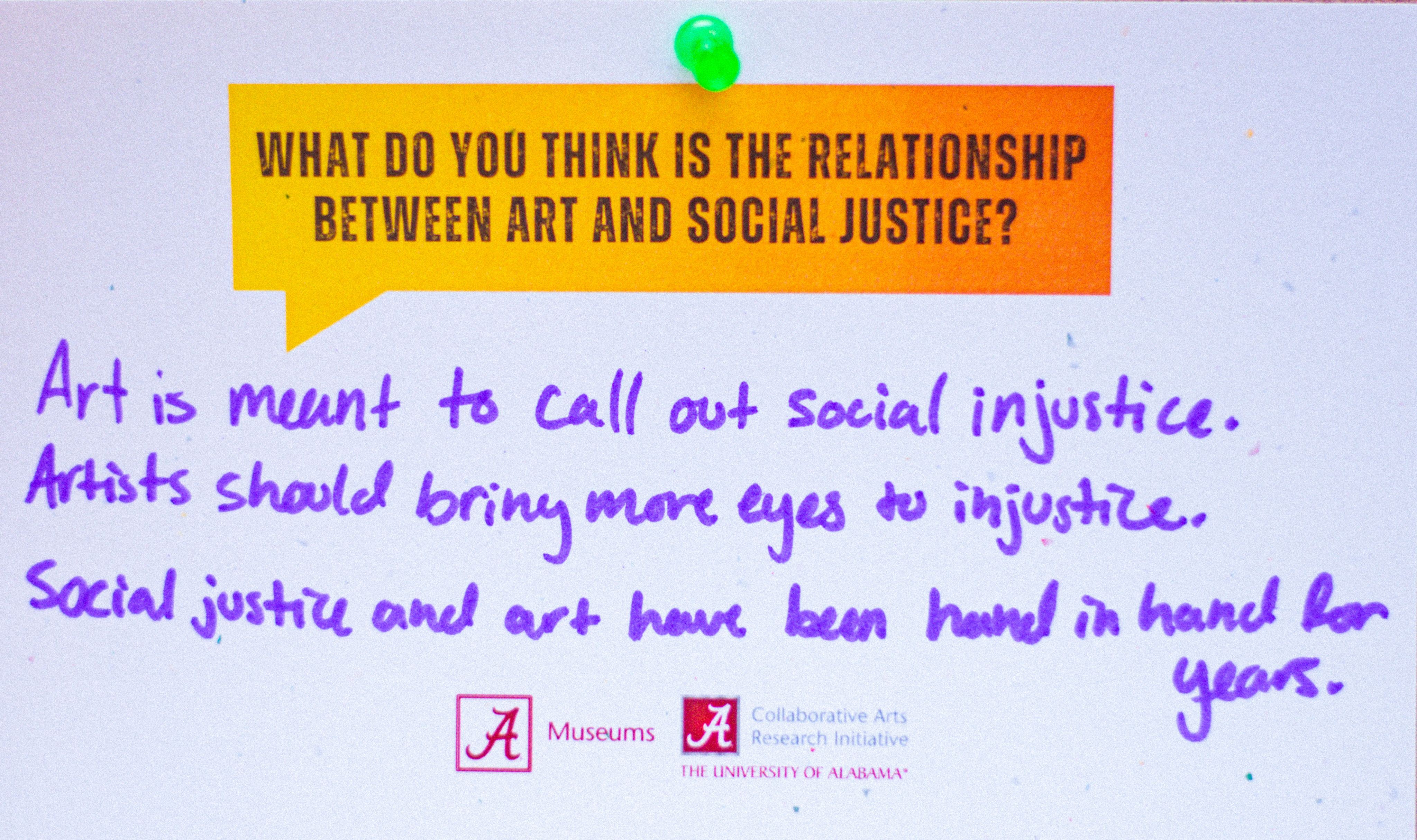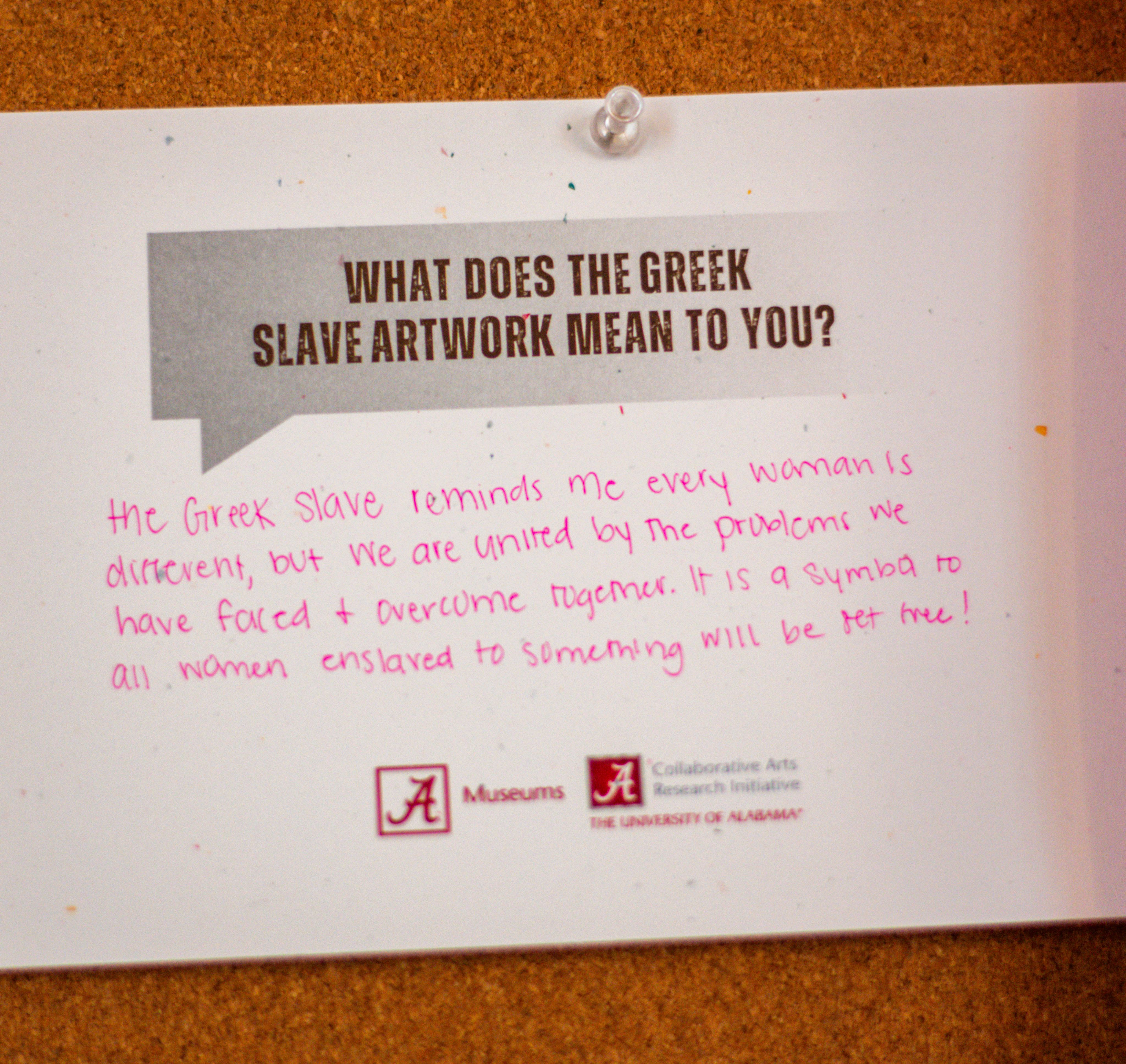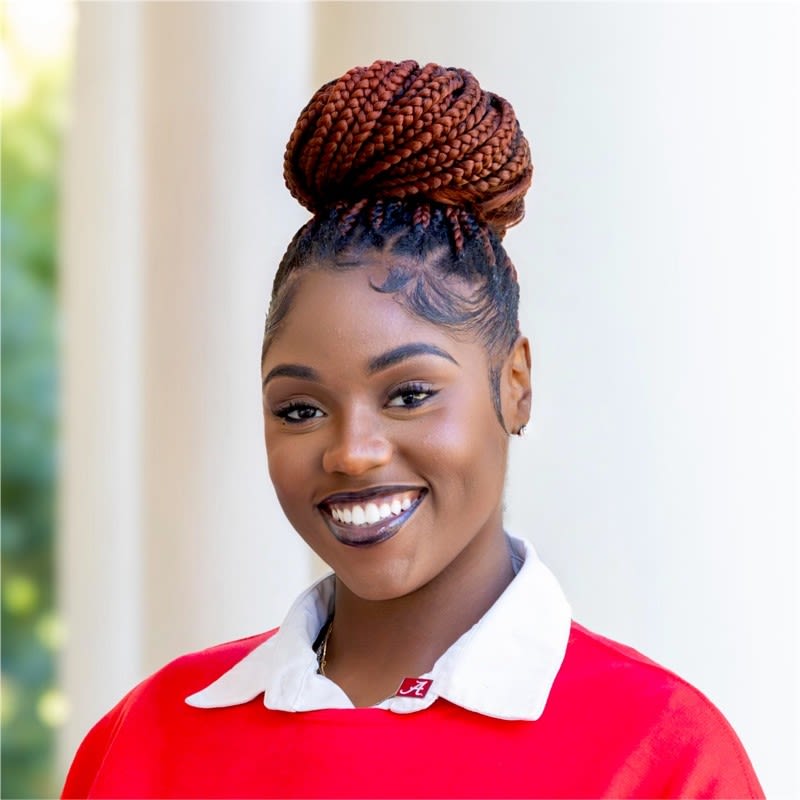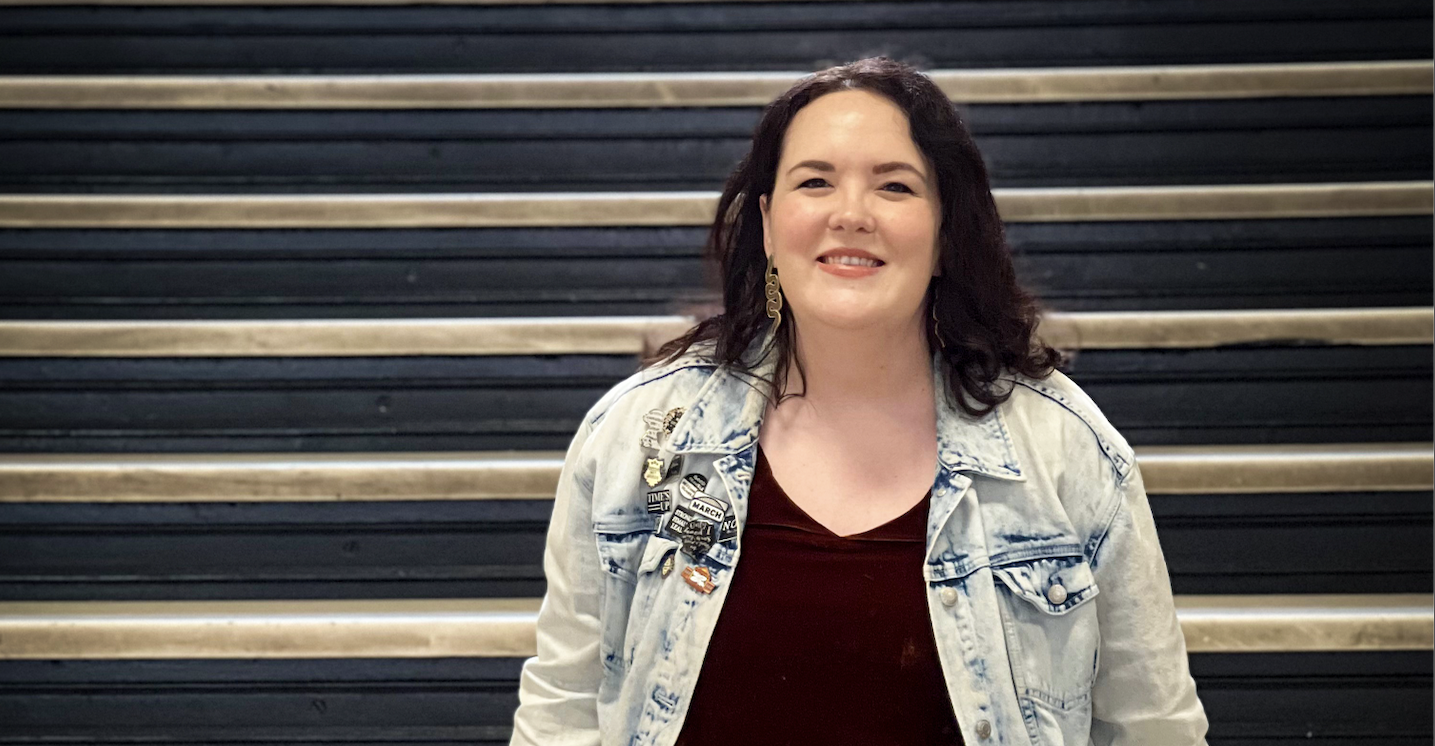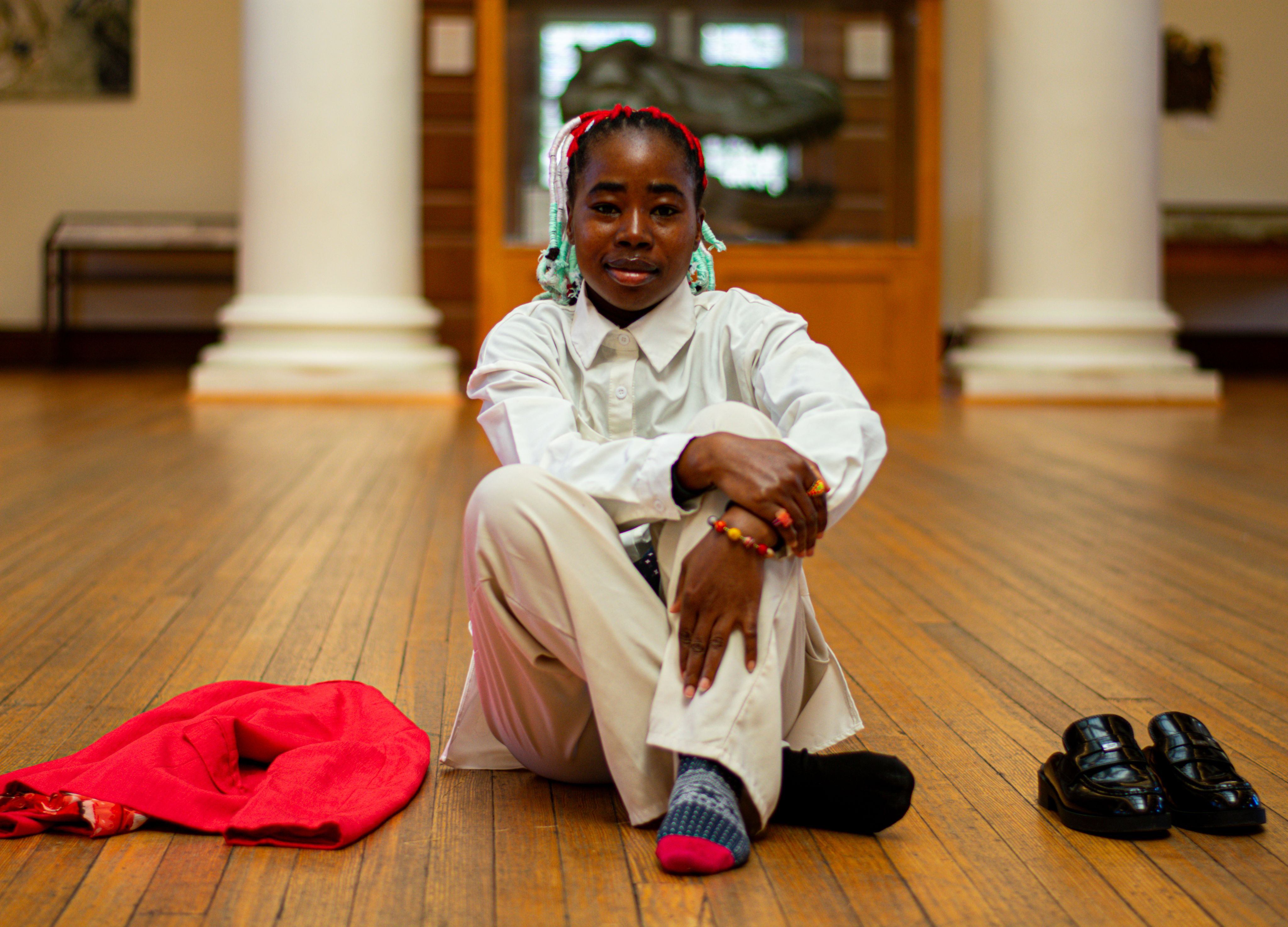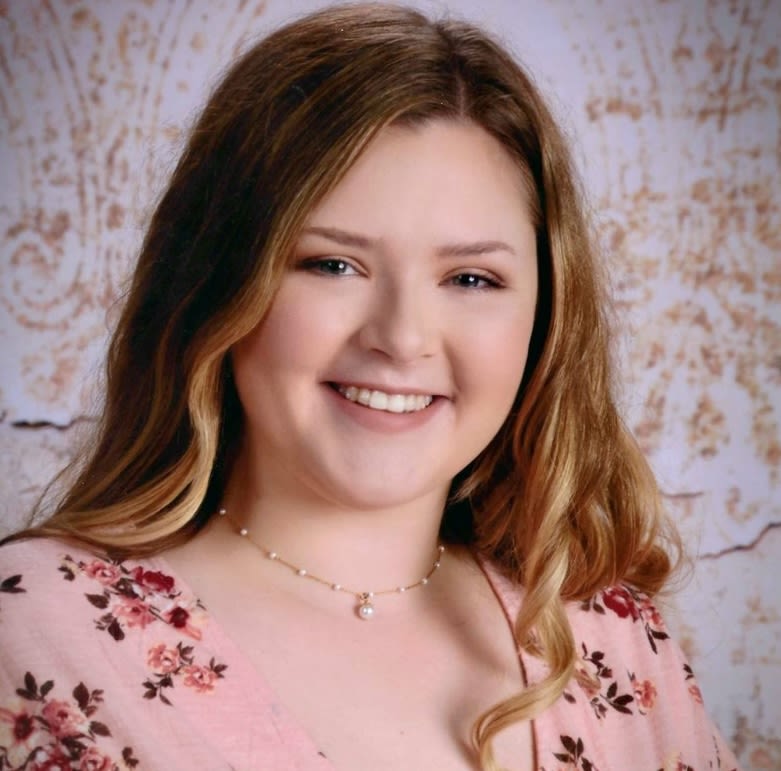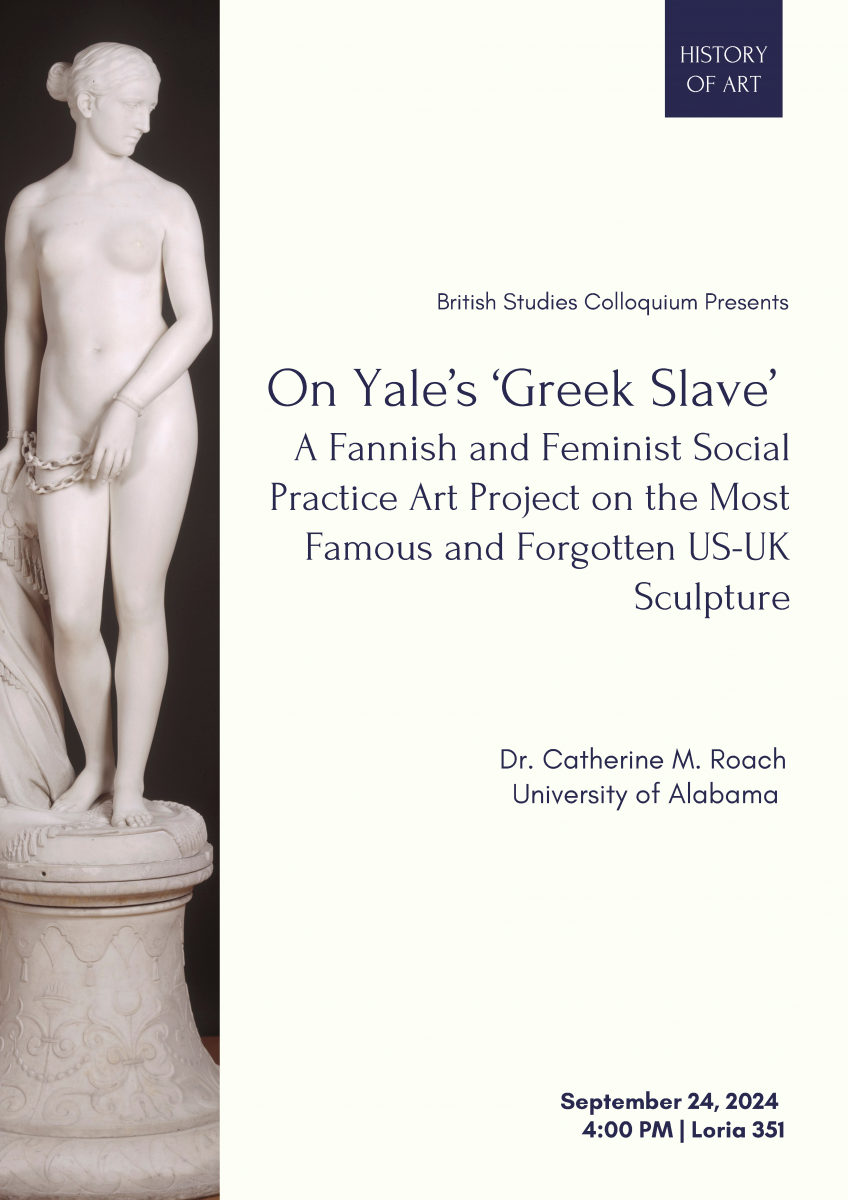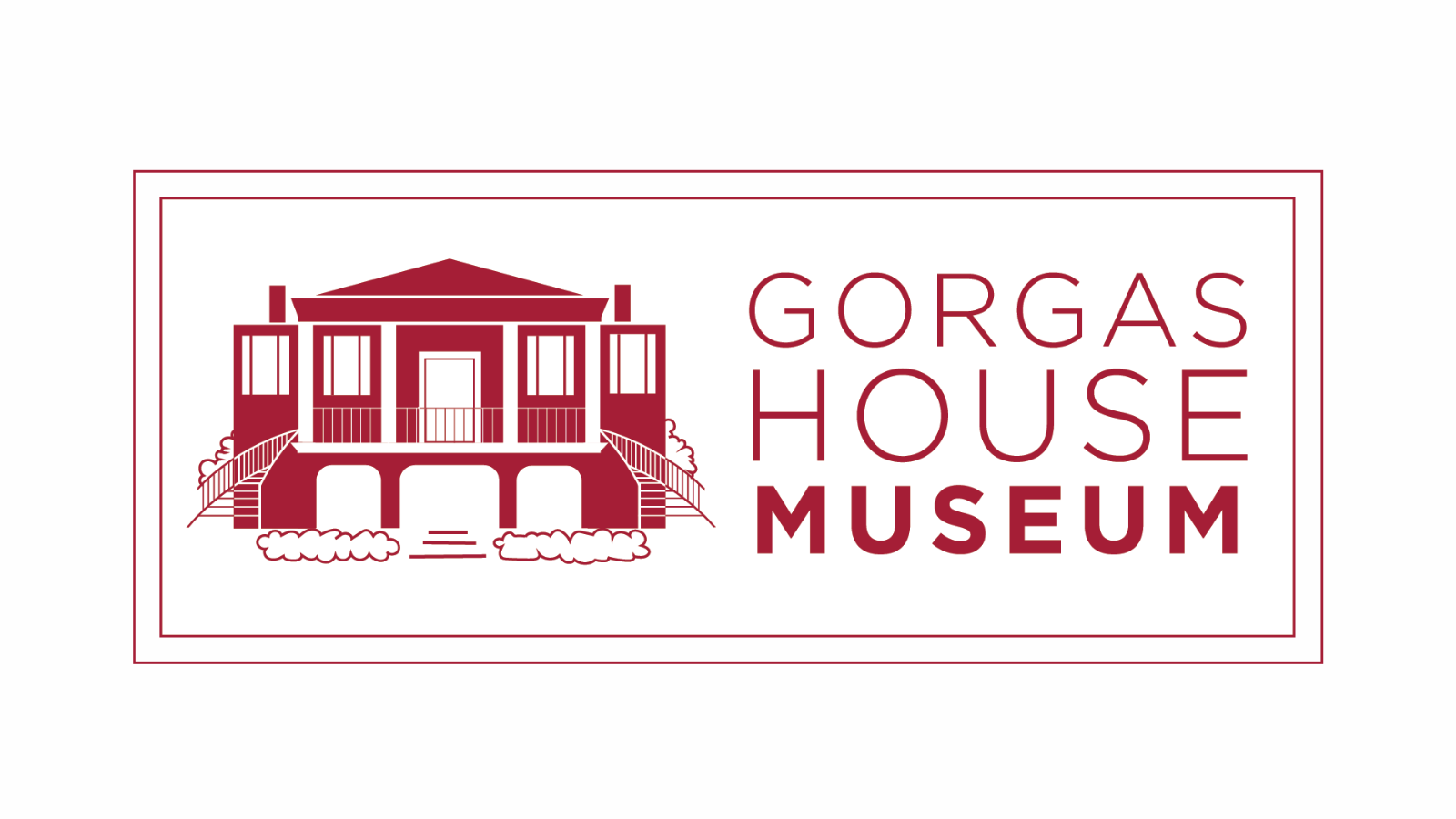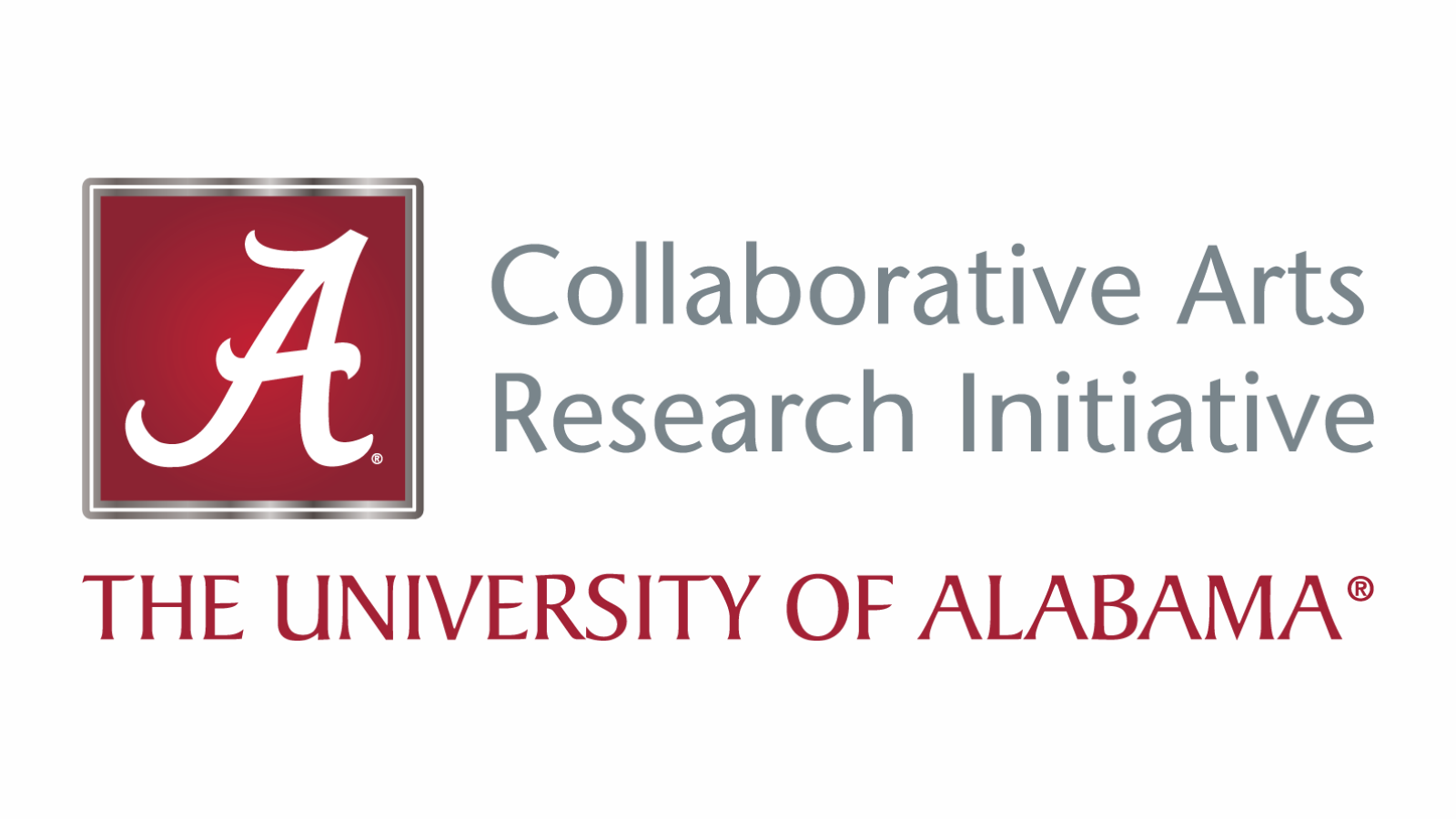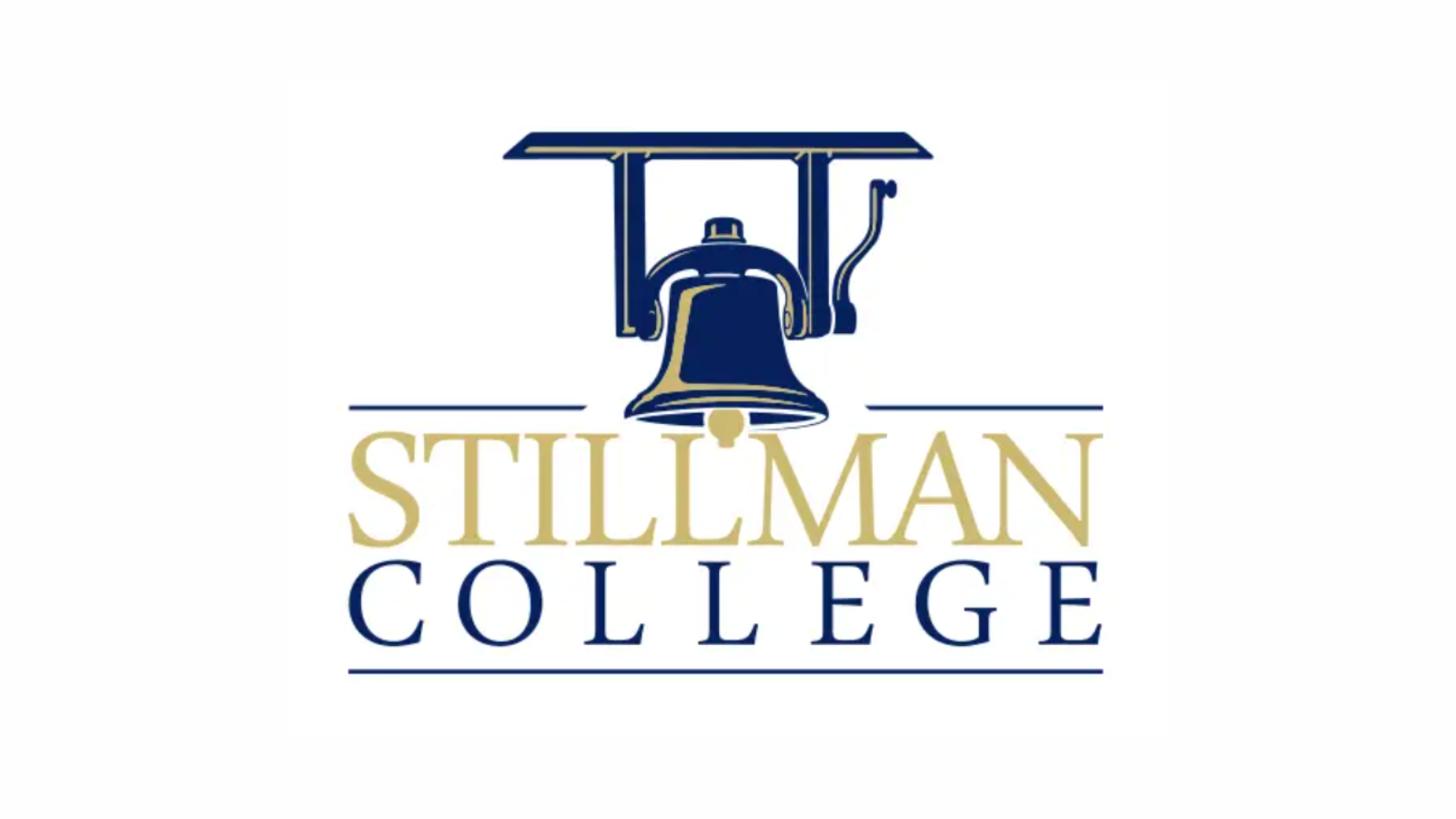Art's Fiery Finger
From March 6 through March 31, 2025, the Gorgas House Museum invited visitors to a multimedia and participatory art installation on the relationship between art and social justice highlighting The Greek Slave – the most viewed sculpture of the 19th century.
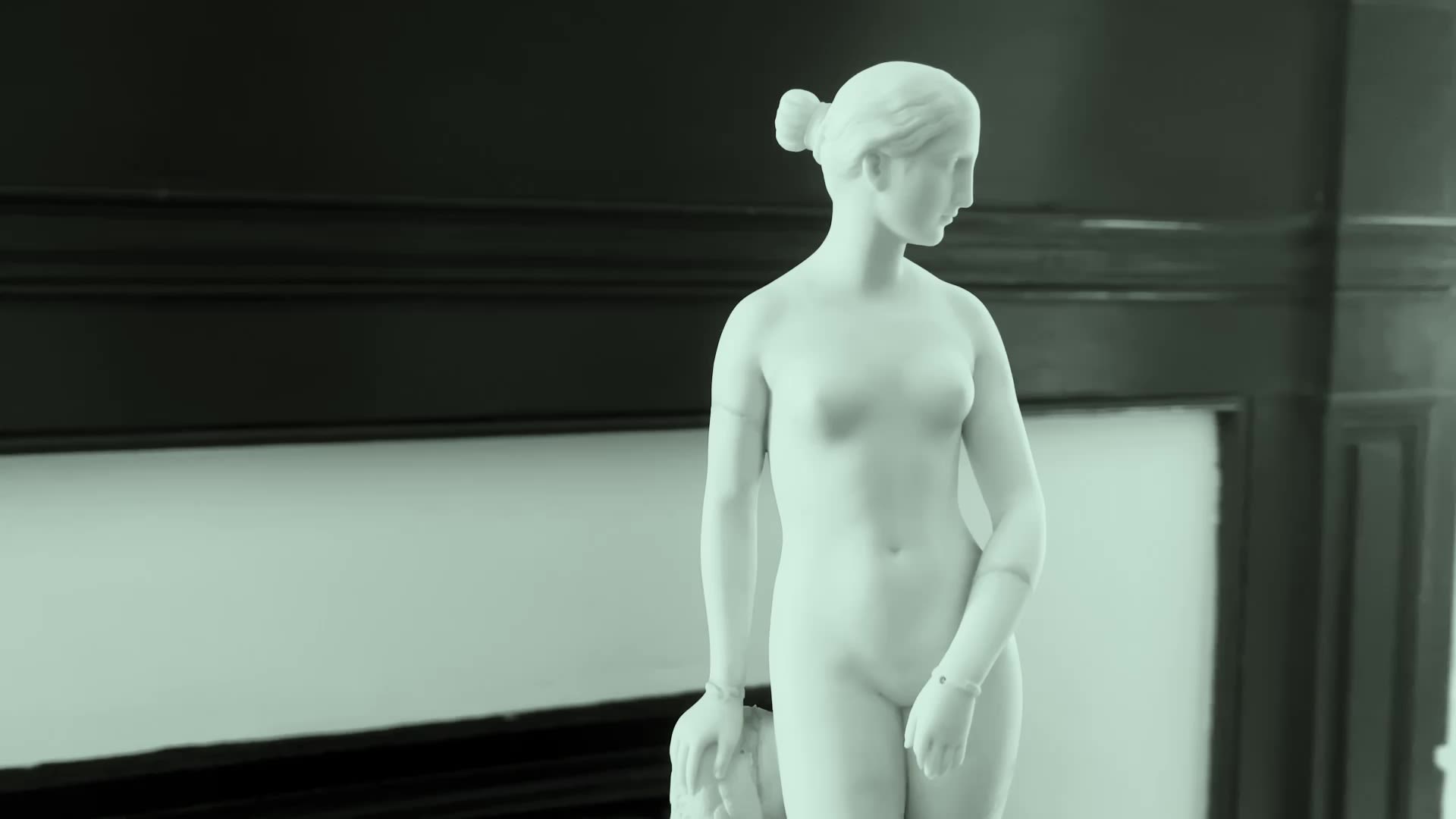
This Shorthand story was created by Rebecca Johnson (Communications Specialist, The University of Alabama Museums) and Sonya Harwood-Johnson (Director, the Gorgas House Museum). 2025.
Sculpted by Hiram Powers, the Greek Slave was first modeled in the early 1840s and then carved in at least 6 full-size marbles through the 1870s. The Gorgas House Museum at The University of Alabama has a small version of this statue in its collection. According to records, the statue has been in the home since 1878, when the Gorgas family moved in. This Greek slave statue is considered an icon of American art history. Currently, full-size versions of this statue are held at the Smithsonian American Art Museum and seven other major museums in the United Kingdom and the United States. In the Greek Slave, Hiram Powers depicts a chained woman who's been captured in Greece by the Ottoman Empire during the 1820s Greek War of Independence and then taken to Constantinople, where she's been stripped naked and standing chained on the auction block, about to be sold.
The Greek Slave was both a controversial and hugely popular statue, becoming the most viewed sculpture in the 19th century. It was America's first female nude statue, taken as a reference after African American slavery. So many people within the United States and the UK were familiar with this piece that it was considered as well known as the Mona Lisa is today -- an integral part of the visual and popular culture of the time.
The Greek Slave was at the center of debates about abolition in its era, and the growing women's rights movement. Some abolitionists, such as Frederick Douglass, adopted the Greek slave as a symbol of anti-slavery art. He kept a miniature in his home, just like there is a miniature kept in the Gorgas House Museum. To quote the Fine Arts Museum of San Francisco, "The fact that this idealized sculpture galvanized international opposition to slavery more effectively than the harsh realities of actual enslaved black people suggests the racism of a white population was better able to empathize with the subject with which they identified."
While the statue was used by some to promote human rights, it is not without controversy. The Greek Slave plays into the trope of endangered pure white womanhood and obscures or evades white culpability for the Atlantic slave trade. It creates support for abolition but is also admired by those who don't support abolition at all. The Greek Slave is a multivalent piece of art that shows how art can mean very different things to very different viewers. The "Art's Fiery Finger" exhibit and symposium worked to further this discussion and discover what this instrumental piece of art means in the 21st century.
- Written by Sonya Harwood-Johnson
Exhibit Panel from "Art's Fiery Finger: The Greek Slave Story of Social Justice and the 19th-Century Art" at the Gorgas House Museum. Designed by Hannah Spencer.
Exhibit Panel from "Art's Fiery Finger: The Greek Slave Story of Social Justice and the 19th-Century Art" at the Gorgas House Museum. Designed by Hannah Spencer.
Exhibit Panel from "Art's Fiery Finger: The Greek Slave Story of Social Justice and the 19th-Century Art" at the Gorgas House Museum. Designed by Hannah Spencer.
Exhibit Panel from "Art's Fiery Finger: The Greek Slave Story of Social Justice and the 19th-Century Art" at the Gorgas House Museum. Designed by Hannah Spencer.
Exhibit Panel from "Art's Fiery Finger: The Greek Slave Story of Social Justice and the 19th-Century Art" at the Gorgas House Museum. Designed by Hannah Spencer.
Exhibit Panel from "Art's Fiery Finger: The Greek Slave Story of Social Justice and the 19th-Century Art" at the Gorgas House Museum. Designed by Hannah Spencer.
Narrative Justice and the Arts Symposium
On Friday, March 28, 2025, the public was invited to the free “Narrative Justice and the Arts” symposium at The University of Alabama from 9:00 a.m. until 12:30 p.m. in the English Building (Room 301). This symposium accompanied the exhibit “Art’s Fiery Finger! The Greek Slave Story of Social Justice and 19th-Century Art,” on view at the Gorgas House Museum. Incubating arts-research on the legacy of slavery and the intersection of racial/gender/sexual justice today, centered on two statues: Hagar by Edmonia Lewis and the Greek Slave by Hiram Power. This symposium was in collaboration with The University of Alabama’s Collaborative Arts Research Initiative and in partnership with Stillman College.
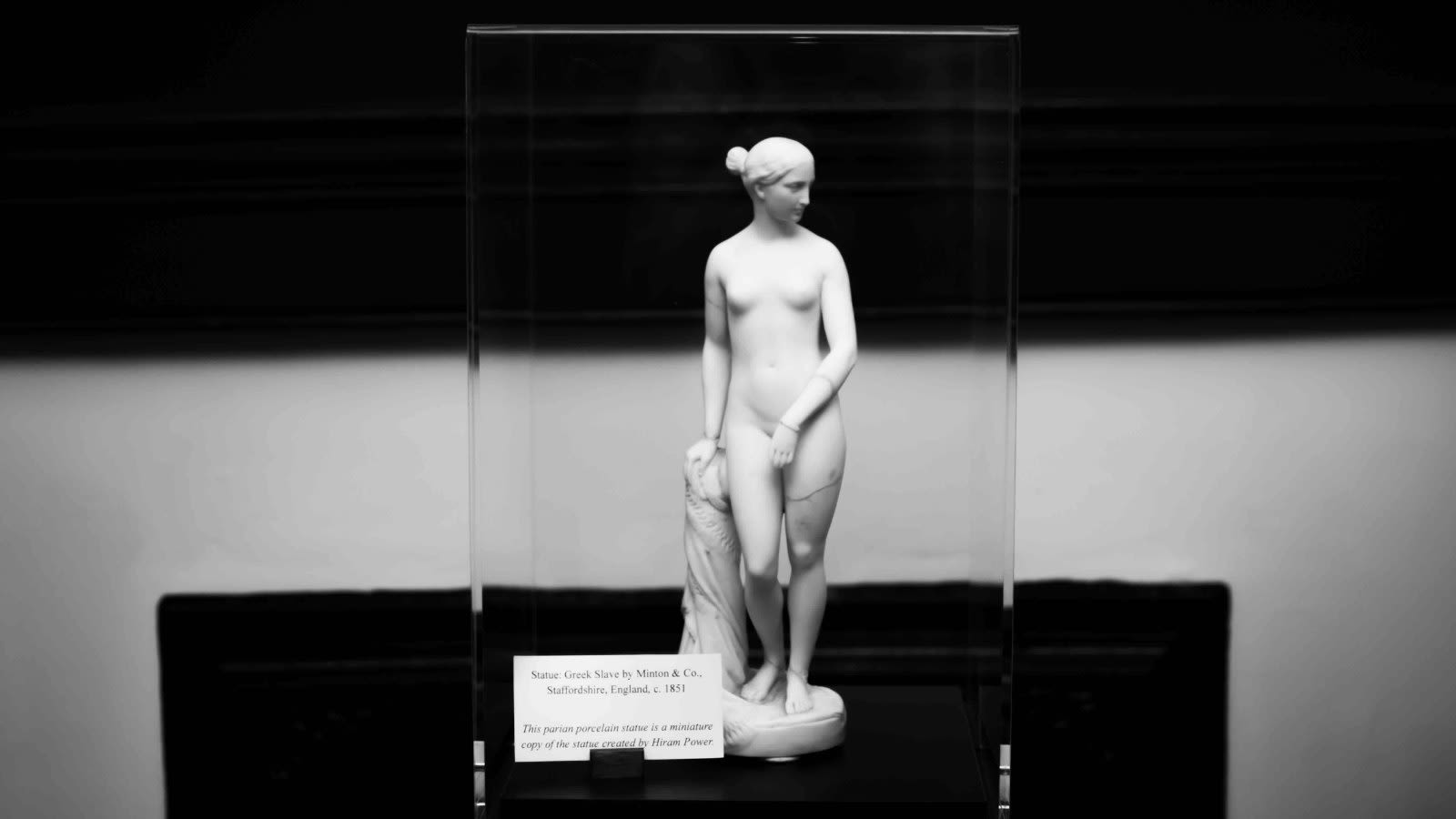
Featured Speakers
Hannah Drake
Co-founder of (Un)Known Project
“Sacred Spaces, Shared Histories: The Transformative Power of Art"
Video Credit: Rebecca Johnson
Josh Miller
Co-founder of (Un)Known Project
“Sacred Spaces, Shared Histories: The Transformative Power of Art"
Video Credit: Rebecca Johnson
Robin Boylorn
Director of the Holle Center (The University of Alabama)
“A New Narrative Justice Initiative at UA”
Video Credit: Rebecca Johnson
New Alabama Studio
Barbara Brickman, Jamilah Cooper, Holland Hopson, John Haley
“Arts-Research at the Intersection of Racial and Gender Justice: Field Song, A Docu-poem”
Video Credit: Rebecca Johnson
Mark McCormick
Provost and Vice President for Academic Affairs (Stillman College)
“The Story of Hagar in Text and Image”
Video Credit: Rebecca Johnson
Dr. Jenny Shaw and Students
Associate Professor, Department of History (The University of Alabama)
“The History of Enslaved People at UA, 1828-1865, part of the consortium Universities Studying Slavery”
Video Credit: Rebecca Johnson
We are putting the Greek slave statue in conversation with the Hagar statue.
Dr. Catherine Roach
"Art's Fiery Finger: The Greek Slave Story of Social Justice and the 19th-Century Art" at the Gorgas House Museum. Photo Credit: Rebecca Johnson
"Art's Fiery Finger: The Greek Slave Story of Social Justice and the 19th-Century Art" at the Gorgas House Museum. Photo Credit: Rebecca Johnson
Photo Credit: Rebecca Johnson
Photo Credit: Rebecca Johnson
Photo Credit: Rebecca Johnson
Photo Credit: Rebecca Johnson
Photo Credit: Rebecca Johnson
Photo Credit: Rebecca Johnson
Photo Credit: Rebecca Johnson
Photo Credit: Rebecca Johnson
Photo Credit: Rebecca Johnson
Photo Credit: Rebecca Johnson
Photo Credit: Rebecca Johnson
Photo Credit: Rebecca Johnson
"Edmonia Lewis Lights a Fire" (working title) is a performance that served as an experimental seed piece created. It was devised by Kelley Schoger and cast members to explore the dramatic possibilities of Edmonia Lewis’ life and art based upon the writings and research of Catharine Roach, Yolanda Manora, and poet Hannah Drake, in addition to their own research into her life. Inspiration for the piece came from the kinetic possibilities of Edmonia’s sculptures and her resilience and artistry despite the obstacles she faced.
Art and Social Justice Roundtable
On Wednesday, March 26, 2025, panelists from a wide variety of backgrounds spoke at The University of Alabama's Intercultural Center on how art can be a powerful tool in modern and historical contexts to work as a vehicle of social justice. This event was free and open to the public and followed by a reception and exhibit tour at the Gorgas House Museum. Panelists included Shanaya Daughtrey, Madeline Burkhardt, Oluwafunmilayo Miriam Akinpelu, and Lauren Waters.
Shanaya Daughtrey
Shanaya Daughtrey is a passionate advocate for voting rights, civic engagement, social justice, and education. She holds a Master’s in Public Administration and a Bachelor’s in Political Science and Journalism from The University of Alabama, where she graduated Summa Cum Laude. In her role as a School Experiential Education Associate at UA’s School of Social Work, Shanaya facilitates student internships, manages agency contracts, and leads voter outreach initiatives to strengthen civic engagement. Her experience in policy and grassroots advocacy includes conducting legislative research and policy analysis as a Capitol Scholars intern with Van Scoyoc Associates. She has also worked with Return My Vote/Greater Birmingham Ministries on voter restoration efforts and assisted with constituent services in Congresswoman Terri Sewell’s office. A former Woke Vote Fellow, Shanaya has organized town halls, voter engagement efforts, and political education initiatives to empower communities. As the author of Generation Z: The Sleeping Giant Awakens—We Have The Power, she has spoken at national voting rights conferences and on platforms discussing DEI, voting rights, and activism. Committed to driving change, Shanaya continues to champion advocacy, education, and civic empowerment.
Madeline Burkhardt
Madeline Burkhardt is the Research Outreach Coordinator at the Alabama Museum of Natural History (ALMNH) at The University of Alabama. She contributes to, develops, manages, and implements museum exhibits and educational programs for all age groups. She also works with UA faculty and staff to help them disseminate the broader impacts of their UA-based research. Madeline received her Bachelor of Arts in Art History with a minor in Italian Studies from Auburn University & her Master of Arts in Museum Studies from Johns Hopkins University. She was previously the Education Coordinator and Curator at the Rosa Parks Museum, where she implemented programs and hosted exhibitions that directly addressed relevant social justice issues and the current civil rights movement.
Oluwafunmilayo Miriam Akinpelu
Oluwafunmilayo Miriam Akinpelu is a doctoral student in the English Literature program with a passion for exhibition and an impressive resume to show her talent and skill for her future museum career. Through her graduate work here at UA and her master’s degree at Central European University, Hungary, Oluwafunmilayo has found every opportunity to gain experience and knowledge about the museum field. She has interned at several museums and archives in Europe and led and curated ten different museum exhibitions and public programs throughout the University of Alabama and the Tuscaloosa community. Her next goal as she works to finish her PhD is to be part of the inaugural University of Alabama Museum’s in Greece internship program in the summer of 2025, which will not only allow her to complete the Museum Studies Certificate, but also gain valuable skills in international collaboration, research, and curation to bring back to her work at UA and in her future museum career.
Lauren Waters
Lauren Waters is an undergraduate Creative Media major with a minor in Art, dedicated to bringing awareness to underrepresented communities through creative expression. Her largest body of work highlights the transgender communities in Tuscaloosa and Birmingham, Alabama, aiming to shed light on their experiences, challenges, and resilience. Lauren serves as the secretary for the Art Photography Club and works as a photographer for Alice Magazine, engaging in visual storytelling and creative collaboration. Through her art, she strives to amplify voices that are often overlooked, fostering greater visibility and understanding.
British Studies Colloquim
Catherine Roach gave an invited lecture at Yale University on the research and the UA symposium plan: “On Yale’s Greek Slave: A Fannish and Feminist Social Practice Art Project on the Most Famous and Forgotten US-UK Sculpture,” British Studies Colloquium, Yale University, Sept. 2024.
The Greek Slave is widely described as the most viewed sculpture of the 19th century. This controversial icon of art history—America’s first female nude, inspired by Greece’s struggle for independence, referencing American slavery—was central to the visual culture of the UK and the US. It galvanized debates about abolition and women’s changing role in society. The Yale University Art Gallery holds an original full-size version, from 1850. The University of Alabama, where Catherine Roach is an interdisciplinary humanities professor, holds two other versions of the Greek Slave. This talk explores her project of fan passion for this transatlantic artwork, viewed as an open site of ongoing storytelling. She draws on fandom as methodology, critical love studies, Goddess imagery, and art practices of letterpress and 3D printing to explore the statue’s relevance at the intersection of racial, gender, and sexual justice today. Working with her students and as part of a Southern collaborative, she asks: What happens when we return attention to this Venus figure and try to create reparative space for power narratives to emerge of resistance, resilience, talkback, and community?
Gorgas House Museum
As a cornerstone of The University of Alabama, the Gorgas House Museum serves as an active community resource, committed to learning through exhibition, education, and social engagement.
Collaborative Arts Research Initiative
The Collaborative Arts Research Initiative (CARI) is an interdisciplinary, arts-focused research engine driven by the interests of faculty from across the University.
Stillman College
Stillman College is a liberal arts institution with a historical and formal affiliation with the Presbyterian Church (U.S.A.). It is committed to fostering academic excellence, to providing opportunities for diverse populations, and to maintaining a strong tradition of preparing students for leadership and service by fostering experiential learning and community engagement designed to equip and empower Stillman’s students and its constituents.
